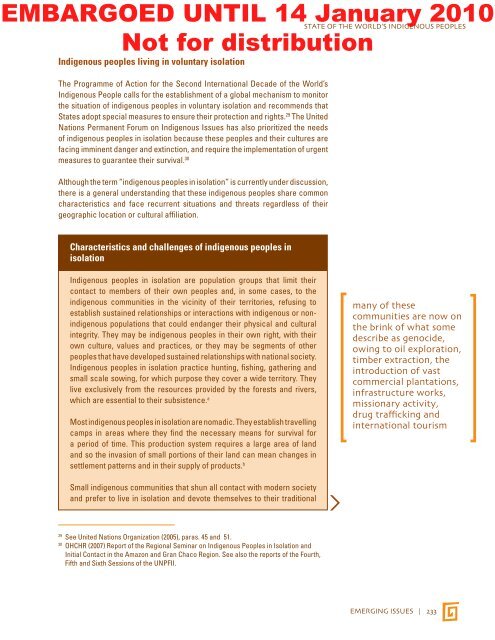STATE OF THE WORLD's INDIGENOUs PEOpLEs - CINU
STATE OF THE WORLD's INDIGENOUs PEOpLEs - CINU
STATE OF THE WORLD's INDIGENOUs PEOpLEs - CINU
- No tags were found...
You also want an ePaper? Increase the reach of your titles
YUMPU automatically turns print PDFs into web optimized ePapers that Google loves.
EMBARGOED UNTIL 14 January 2010<strong>STATE</strong> <strong>OF</strong> <strong>THE</strong> WORLD’S INDIGENOUS PEOPLESNot for distributionIndigenous peoples living in voluntary isolationThe Programme of Action for the Second International Decade of the World’sIndigenous People calls for the establishment of a global mechanism to monitorthe situation of indigenous peoples in voluntary isolation and recommends thatStates adopt special measures to ensure their protection and rights. 29 The UnitedNations Permanent Forum on Indigenous Issues has also prioritized the needsof indigenous peoples in isolation because these peoples and their cultures arefacing imminent danger and extinction, and require the implementation of urgentmeasures to guarantee their survival. 30Although the term “indigenous peoples in isolation” is currently under discussion,there is a general understanding that these indigenous peoples share commoncharacteristics and face recurrent situations and threats regardless of theirgeographic location or cultural affiliation.Characteristics and challenges of indigenous peoples inisolationIndigenous peoples in isolation are population groups that limit theircontact to members of their own peoples and, in some cases, to theindigenous communities in the vicinity of their territories, refusing toestablish sustained relationships or interactions with indigenous or nonindigenouspopulations that could endanger their physical and culturalintegrity. They may be indigenous peoples in their own right, with theirown culture, values and practices, or they may be segments of otherpeoples that have developed sustained relationships with national society.Indigenous peoples in isolation practice hunting, fishing, gathering andsmall scale sowing, for which purpose they cover a wide territory. Theylive exclusively from the resources provided by the forests and rivers,which are essential to their subsistence. aMost indigenous peoples in isolation are nomadic. They establish travellingcamps in areas where they find the necessary means for survival fora period of time. This production system requires a large area of landand so the invasion of small portions of their land can mean changes insettlement patterns and in their supply of products. bmany of thesecommunities are now onthe brink of what somedescribe as genocide,owing to oil exploration,timber extraction, theintroduction of vastcommercial plantations,infrastructure works,missionary activity,drug trafficking andinternational tourismSmall indigenous communities that shun all contact with modern societyand prefer to live in isolation and devote themselves to their traditional29See United Nations Organization (2005), paras. 45 and 51.30 OHCHR (2007) Report of the Regional Seminar on Indigenous Peoples in Isolation andInitial Contact in the Amazon and Gran Chaco Region. See also the reports of the Fourth,Fifth and Sixth Sessions of the UNPFII.EMERGING ISSUES | 233
















